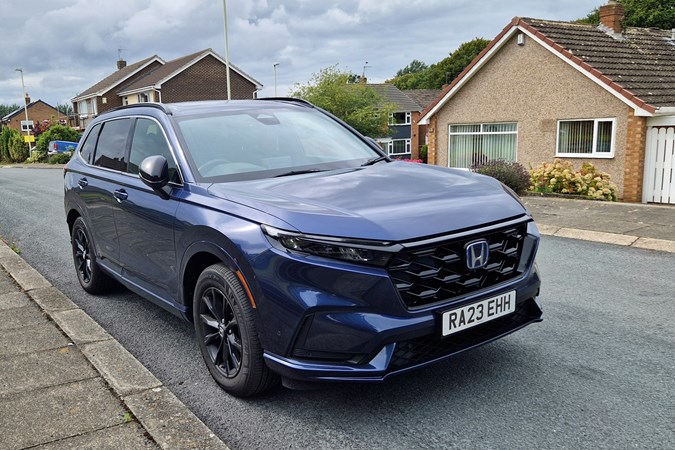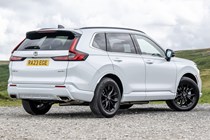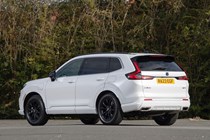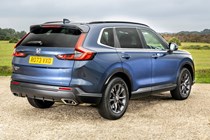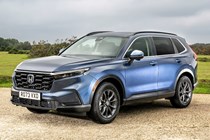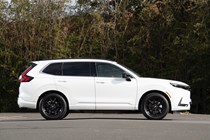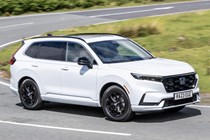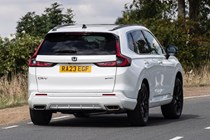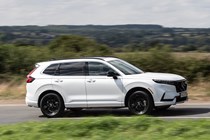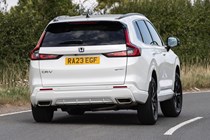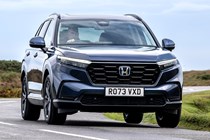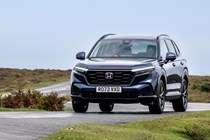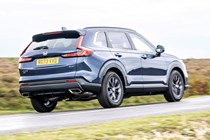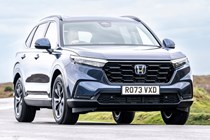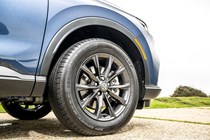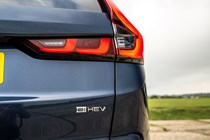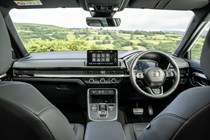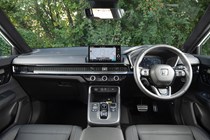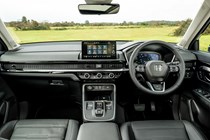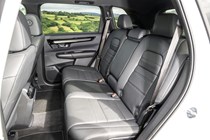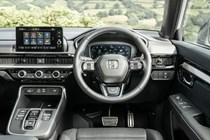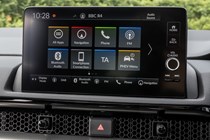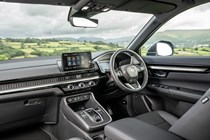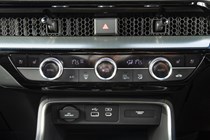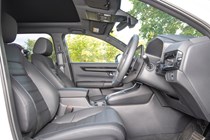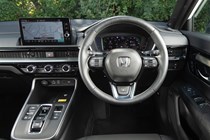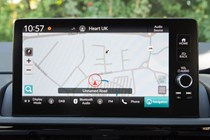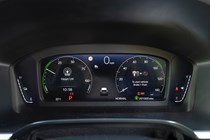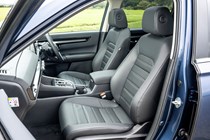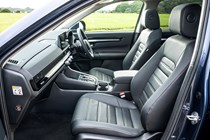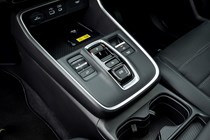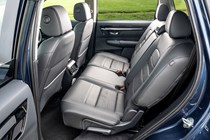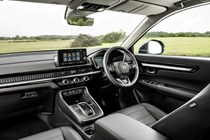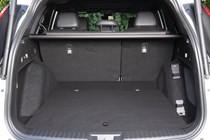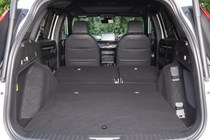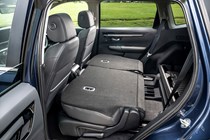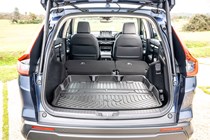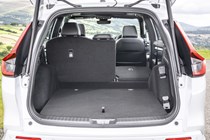
Honda CR-V long-term test
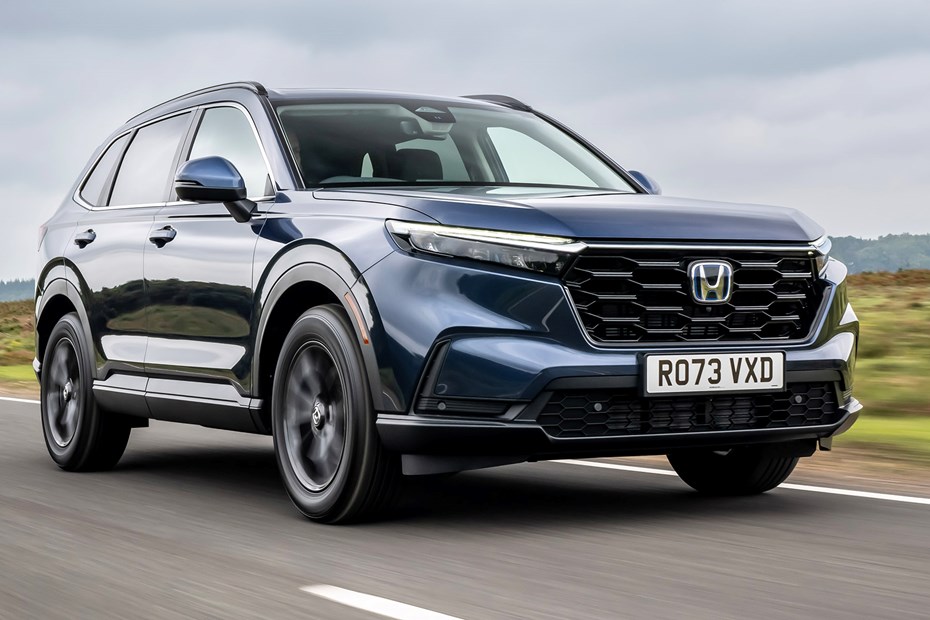
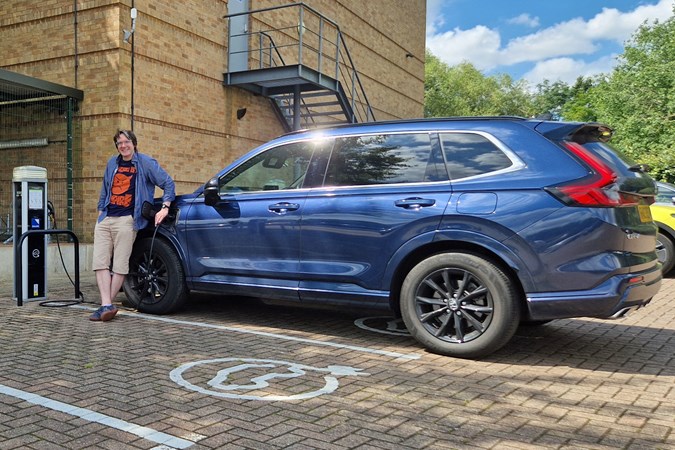
Welcome to Parkers’ long-term test of the Honda CR-V, where we’ll go beyond the usual week-long press loan of this popular family SUV to find out what it’s really like to live with.
Tested by cj hubbard
Report 1: Could this petrol-electric SUV be a family car star?
Right, this is going to be a bit of a whirlwind, as although this is a long-term test, I’ve only got access to this Honda CR-V for three months instead of the usual six. So let’s hit the ground running, and dive straight into what this is like as a family car.
I’ll aim to mix fewer metaphors as we go on, but one other thing to note straight away is that the vehicle is not brand new. Rather, it’s a veteran of the Honda press fleet, and arrives in the Parkers car park with over 10,000 miles on the clock. No bad thing, as it allows me to consider what it might be like as a used car purchase as well as experience its fundamental everyday useability.
Which version of the Honda CR-V are you testing?
EHH – which always makes me laugh, for some reason – is a top of the range Honda CR-V, meaning an e:PHEV model in that variant’s singular and bespoke Advance Tech specification. This means an eye-watering basic list price of £53,995 for what most people would consider a non-premium SUV, an equally results in quite a lot to unpack immediately.
The e: signifies electrification, as it does with any modern Honda, while PHEV stands for plug-in hybrid electric vehicle. I’m probably teaching many of you to suck eggs here, but Honda’s approach to hybrids is reasonably interesting as both this model and the regular e:HEV self-charging hybrid that makes up the rest of the CR-V range features a very similar powertrain.
Both use the same 2.0-litre petrol engine, which produces 148hp and uses the Atkinson injection cycle to maximise efficiency. The difference is that the e:PHEV has a much larger 17.7kWh lithium-ion battery, which can only be fully charged by plugging it into the mains. Whereas the e:HEV’s smaller battery only gets replenished automatically as you drive.

However, because they are so fundamentally similar beyond this point, the e:PHEV acts just like the e:HEV when its battery is run down – so I should still see a fuel economy benefit compared with a conventional petrol SUV. And when the battery is fully charged, a theoretically 50 miles of non-stop electric-only driving is possible.
There are further complications, though. The e:HEV models are all-wheel drive, while the e:PHEV I’ve got is two-wheel drive. This won’t matter too much in the kind of driving I’m likely to be doing in three months over summer, but does somewhat surprisingly mean the e:PHEV has the bigger boot; usually, a plug-in hybrid model has less load capacity due to the bigger battery. Things being the opposite way round in the CR-V is ideal for me, given my need to carry all the gubbins required by a pair of small children.
Honda also reckons the e:PHEV is more refined than the e:HEV because the bigger battery means the electric motor can assist more of the time, allowing the petrol engine to run at reduced revs – something made possible by integration between the electric motor and the continuously variable transmission (CVT). Without doing a back-to-back comparison this will be hard to qualify, but I will say that my e:PHEV is very quiet.
Other points of difference include various trimmings – the e:PHEV has darker headlining and a dubiously more sporty vibe (I’ll explain the dubious part in a moment) – and also comes with adaptive damping as standard, which isn’t available on other UK CR-Vs.
What are its family car super-powers?
The CR-V – and especially the e:PHEV – is absolutely crammed with safety equipment. This includes a 360-degree sensor package, which is almost too alert to cross traffic but is yet to over-react with false-positive emergency braking, but also no less than eleven airbags. As standard.
In fact, the fitted equipment list is enormous – in order to simplify Honda’s WLTP commitments, I would guess. The only factory-fitted option available is a choice of paint, in this case £675’s worth of Canyon River Blue Metallic. Yet it still misses out on wireless Android Auto as far as I can tell (despite having a wireless charger), and doesn’t have keyless entry on all four passenger doors.
You can only lock and unlock the CR-V’s passenger compartment without the remote by grabbing the front door handles, which feels like a real step backwards compared with the various Volkswagen Group models I’ve been running around in lately that do allow you to unlock them from any portal. It’s amazing how useful this is when you’re marshalling a rambunctious six-year-old and an 18-month-old who appears to want to be some kind of stunt baby.
There is plenty of space inside, however, and its easy to get our substantial Cybex child seats in and out through the large door openings. Something that wasn’t so straightforward with the Skoda Octavia Estate long-term test car I had previously. The Honda is also very refined, with a smooth and laidback power delivery. My mother-in-law likes it a lot, which is something.
How practical is it proving?
The boot is usefully generous, as advertised, but Honda could learn a thing or two from Skoda about making the load space more user friendly.
For example, there’s no cleverly engineered method for making the false floor stand upright in the CR-V as there is the Octavia, making accessing the charging cables that are inevitably stored there a minor exercise in uncoordinated frustration, as you have to hold a heavy yet not entirely rigid panel upright while extracting an inexorably uncooperative coil of heavy-gauge wire with a couple of knee-cap seeking mallets on each end.
The same panel also has an exceptionally irritating habit of dropping off its mounting points and collapsing into the bottom of the boot. This never happened in the Skoda either.
What are your initial driving impressions?
The drivetrain I like a lot. It juggles the two power sources very effectively, and I especially like the way that, unlike many other plug-in hybrids I’ve driven, it refuses to let the drive-battery deplete entirely. This means even if you never plug it in (ahem), it still runs around on electricity alone a lot of the time around town because it’s intelligently maintaining the ability to do so.
It typically starts as an EV, too, meaning silent 5:30am getaways, which I’m sure the neighbours appreciate. The CR-V is also quick enough at motorway speeds to make my lengthy commute (circa. 164 miles each way) tolerably relaxing.
Since there’s no conventional transmission, it uses battery regeneration via the e-motor to achieve variation in engine braking – controlled by the paddles on the back of the steering wheel. I like to use engine braking, so this also suits me well; I like the thought of saving otherwise lost energy and putting it back into the drive-battery, too, and you don’t get any calm-shattering flare of revs as you do when downshifting in rival PHEVs with a conventional automatic transmission. I have a particular VW Group model in mind here, which I’ll come back to in a future report.
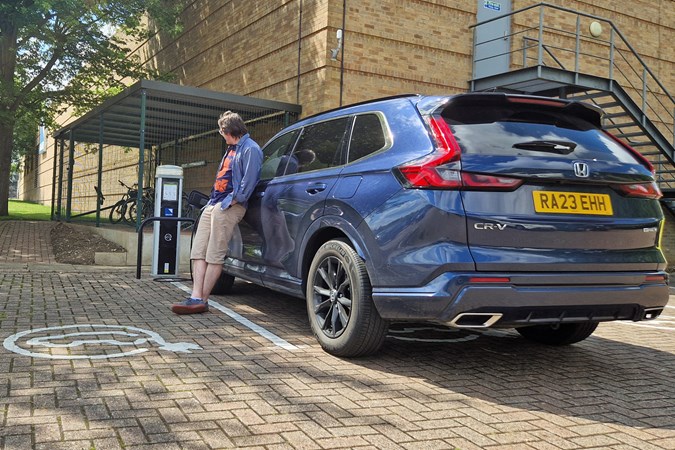
Because the CR-V uses a CVT, you do get an occasional disconnect between the engine note and acceleration – the gearbox enabling the petrol engine to shoot into its maximum powerband regardless of the road speed if you flatten the accelerator. I tend to use the Eco driving mode the most, because it suits the car and lessens this effect by deadening the response a little.
The other driving mode options are Normal, Sport, Snow and Towing. I haven’t had much use for the latter pair, but Normal is exactly that and I have dabbled with Sport enough to understand what the Honda was getting at.
Selecting Sport on more challenging roads – such as those with lots of switchback corners – does tighten up the CR-V’s responses a bit, lessening its natural tendency towards a kind of early, rolly understeer that lacks the crispness of, say, a VW Tiguan (another previous long-term test car).
Unfortunately, Sport mode also comes with an artificially enhanced engine sound that’s just on the cusp of being unignorably grating. Turning up the radio is my usual solution if this does become bothersome, but I’m learning to put up with it – mentioning it here more in the sense that it seems misguided, as this is not generally a very sporty car and the digitally revvyiness is out of place even if you’re pressing on. All it does is draw attention to that limited athletic prowess.
How does the CR-V seem to be bearing up at 10,000 miles?
On the inside, you’d never know this wasn’t a brand-new car. The plastics are showing zero signs of wear, the buttons – yes! There are buttons! – are all nice and consistent and positive to use, and the leather seats look good as new at the moment, too. So far so good, although Android Auto drops connection on an annoyingly regular basis, which appears to be due to aging off the USB-A port in the dashboard. I haven’t had issues with the same phone and cable combo in other cars before or since receiving the CR-V.
On the outside, things aren’t so rosy. For a car that costs £54,670 including ‘upgraded’ paint, that paint would seem to be disappointingly frangible.
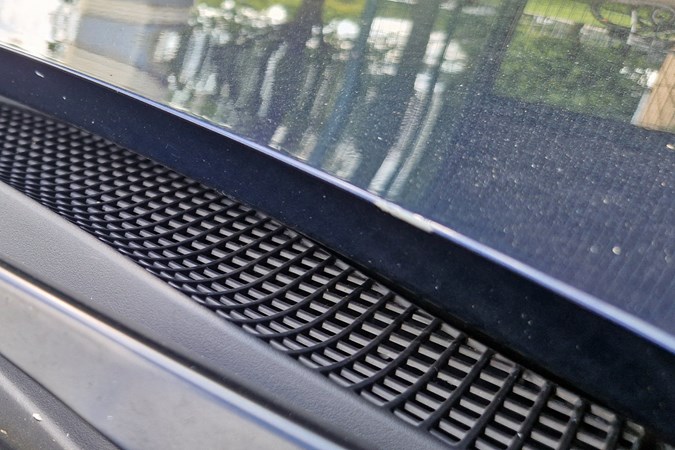
Not only are there numerous marks and scratches around the car – to be expected on a vehicle that’s spent its life on a press fleet being repeatedly handed out to some of the least mechanically sympathetic fellows you can probably imagine – but particularly notable are the two sections on the trailing edge of the bonnet.
These correspond with the location of the windscreen wipers. Obviously, the wipers don’t hit the bonnet in general use. Perhaps, then, someone has opened the bonnet after the wipers have been raised and cause the damage that way?
Turns out to be even weirder than that, because a cursory experiment on my part suggests it’s impossible to even lift the wipers from the screen without the arms hitting the bonnet – effectively meaning there’s no raised position, either. I need to have a look at the manual to figure this out, but I’ve never had to do that before changing wiper blades before, making this curiouser and curiouser. Maybe there’s some kind of aerodynamics related reason for this engineering mystery.
So are you happy with the Honda so far?
At the time of writing this report I’ve driven over 1,000 miles in the CR-V. The minor foibles alluded to above – and they are minor, despite their inevitable prominence in this kind of reporting – aside, I am very much enjoying tooling about in this undemanding and eminently pragmatic family SUV.
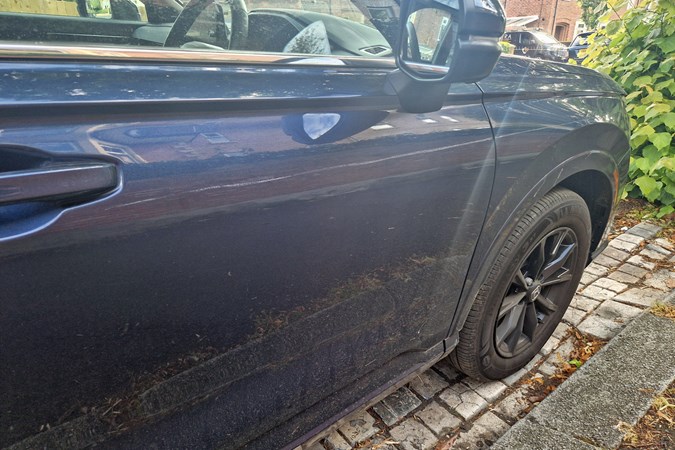
Or at least I was, until some miscreant drove into it outside my house and ran away without leaving any details. Fortunately, the damage appears to be limited to a lengthy scuff delivered by a door mirror, and the CR-V is away with Honda hopefully being polished back into a single colour again.
Told you it had been a whirlwind already.
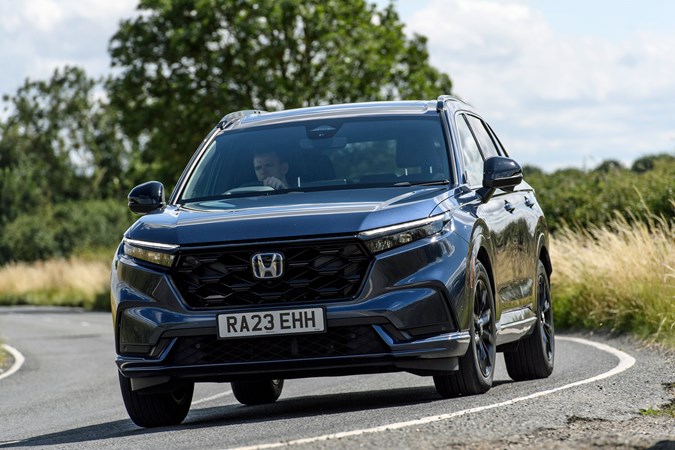
Report 2: Family life with the Honda CR-V plug-in hybrid
The Honda CR-V is back from having its paint polished (superb result; aside from the polish residue in the door rubbers you’d never know there have been an incident – give the techs a medal) and we’ve been cracking on with family life. To which, I have to say, the CR-V is suited to almost perfectly. On with the whirlwind.
Child friendly, with (minor) caveats
While I’ve come to think of it as rather a handsome beast from the front, with a kind of dark and interesting look about the chrome-free grille and narrow headlights that also seems to have a generally positive impact on other traffic, to my eyes the Honda is a little ungainly in profile.
But the resulting interior space grants the kids enough room in the rear that they’re unable to ruin the backs of the front seats with their feet, and the older one can get out on the pavement side of the car crossing in front of the toddler without difficulty.
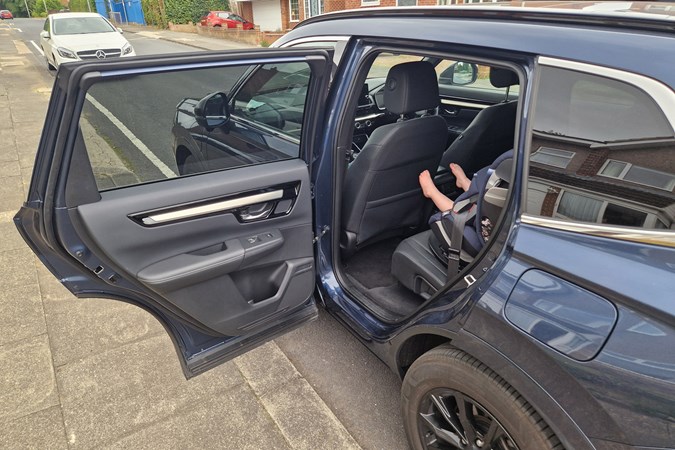
What the six-year-old can’t do is routinely plug the seatbelt into its socket, something she’s mastered in other cars with little hesitation. Turns out it’s not her, either. Our child-seat of choice makes access to the receptacle just slightly too awkward. Though weirdly, we’ve got the same seat on the other side and that doesn’t present any issues – something to do with the difference between the 40:60 split of the rear bench, I guess.
While this is mildly irksome, perhaps more concerning for the long-term value of the vehicle is the interaction between the Isofix connections and the CR-V’s seat based. Fitting the child seats is a dream – seriously, I can’t think of another car recently that gives you such easy passage to the mounting points – but on our Cybex items this then creates a downward angle that pokes into leather.

Over time, I fear that’s going to do quite a bit of damage. To the extent I thought it would a good idea to get some seat protectors in an effort to lessen the literal impact. These seem fine, but I’ve got the CR-V for too short of time to really judge them as a longer-term solution. Better safe than sorry, however.
Final item of note here is that the doors open exceptionally wide – to nearly 90 degrees at the back, in fact. Which aids managing the attachment and detachment of smaller children, even if most carparks are too tight for advantage to be taken.

Two kids, three adults won’t go
This snag is not limited to the CR-V by any means, but two child-seat-bound kiddos makes the middle rear seat basically unusable in the Honda. Which was a bit of a problem when it came to holiday plans that involved also transporting a third adult. This led me to acting a motoring journalist and abandoning the SUV in favour of an old-school family vehicle format: the classic people carrier.
In this instance, a VW Multivan eHybrid, complete with plug-in petrol-electric drivetrain. Purpose-built for maximum practicality, the VW consumed the five of us plus a week’s worth of luggage without blinking. In fact, I kept one of the other two available seats in the boot as well (the Multivan’s a seven-seater, but all the rear seats are individual and removeable – which is exactly what I did with the seventh).
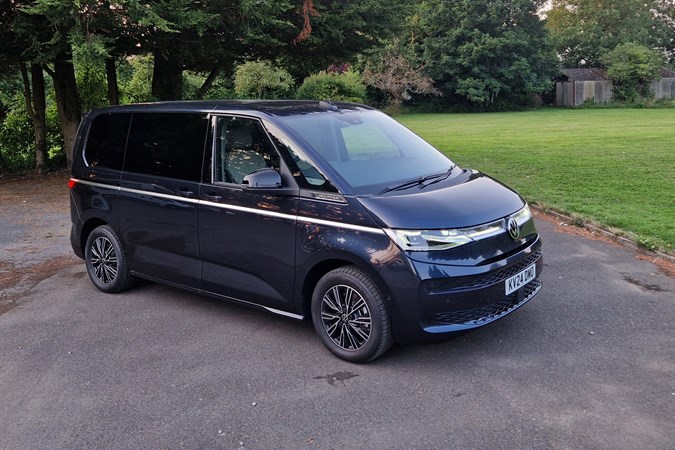
While we still had to stagger the middle row to get three across, such is the size of those child seats, we’d never have got the necessary clobber in the boot of the Honda even if the people had fit. And though I’ve long argued that the best family car is actually a van, this came as a timely reminder: if you’re buying a single vehicle to do it all, consider carefully whether an SUV actually fits the bill.
That’s not to say the Multivan is perfect by any means. The hybrid variant isn’t currently available new (an updated version of the PHEV drivetrain is coming later in 2024). And currently a non-hybrid Multivan will cost hundreds more per month to lease. So there’s a pretty chunky cost consideration if that extra space isn’t necessary. Fuel economy takes a hit, too, the Multivan returning 33.1mpg over 1,000 miles, while the Honda generally gets closer to 40.

The VW hybrid system does allow you to charge the batteries while driving, but I admit I might be among the few that cares about that. More relevant is probably that it’s nowhere near as clever or smooth as the CR-V’s. Using a DSG automatic transmission and a smaller 1.4-litre turbo petrol, it’s much noisier when you want to slow using the gears instead of friction braking, while also presenting the usual DSG foibles of low speed lethargy transitioning into jerky over-enthusiasm. The Honda is, ultimately, far sharper to drive as well, even without that being one of the CR-V’s main selling points.
I’m comparing apples and oranges here, of course. The Multivan is great if you want a seven-seater van – and can afford it. Let’s get back to the main program now…
Full of surprises
My unreasonable seating demands aside, the Honda is going great guns. I love its relaxed but swift demeanour on the motorway, the tolerably punchy Bose hi-fi system and the sensible control layout.
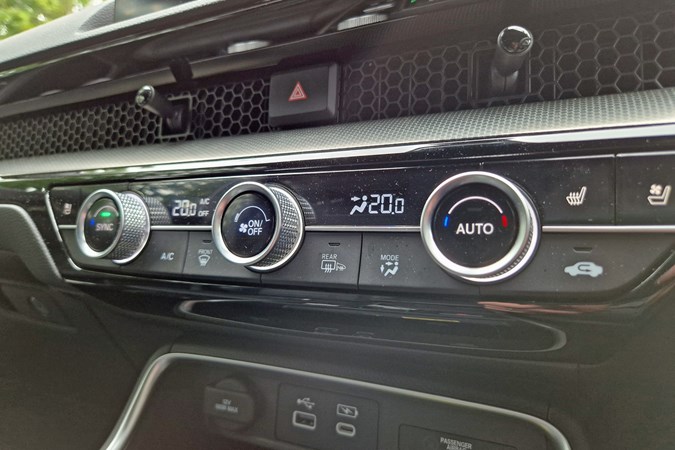
The infotainment system isn’t the sleekest looking by a long shot, but the large icons make it easy to prod on the move and there are the aforementioned physical buttons, which make it a doddle to shortcut from Android Auto to the Honda home screen, for instance. Not to mention the completely separate climate controls, including dials with their own individual displays. Compared with most modern car interiors it is an ergonomic dream.
It’s also got a stack of not so obvious useful features. The cubby hole under the central armrest is deep enough for a reasonably chunky SLR camera and includes a little dual-position tray for smaller items. The middle cupholders will accept a large reusable water bottle – most certainly not always the case even these days.
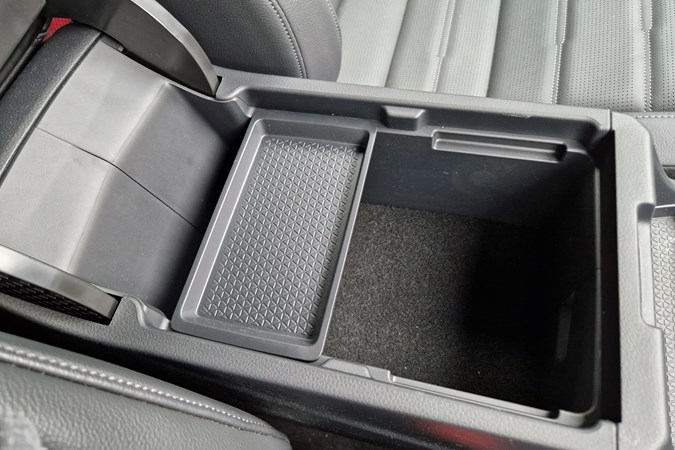
This spec of CR-V also includes a suite of exterior cameras, which I hadn’t fully appreciated until I pressed an icon I didn’t understand on rear-view monitor screen, and accidentally activated the surround-view system. For some reason, not set as the default. And oddly, it disappears from the screen again as soon as you put the car in drive, as if no-one ever needed to see all the way around the outside of the car when creeping forward.
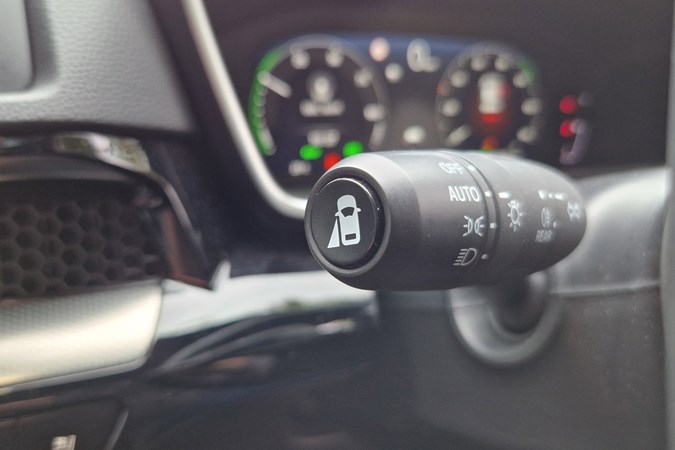
I then discovered the button on the end of the indicator stalks operates a blindspot camera on the passenger side, while the one on the wiper stalk fires up the front-facing perspective. I had been wondering how you got to that, since it only otherwise appears when you get extremely close to something during low-speed manoeuvres.
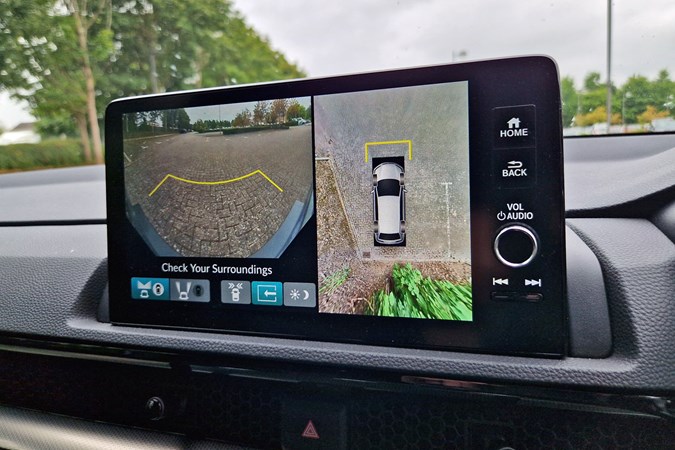
All stuff that makes sense when you know about it; that I’m just discovering it now underlines that maybe reading the manual isn’t such a waste of time after all.
Anyway, there will be a further, final report on CR-V soon, then it’s off on its way again.
Shame, because as you can surely tell, I’m already certain I’m going to miss it.
Report 3: Goodbye to the CR-V, then – it’s been short but very sweet
The time has come for the Honda CR-V plug-in hybrid to go home, and three months really doesn’t feel like enough time with this car. If you’ve read the previous two reports, it will come as no surprise that I think this is fantastic family transport: comfortable and well thought-out, with a good level of practicality and unexpectedly decent performance.
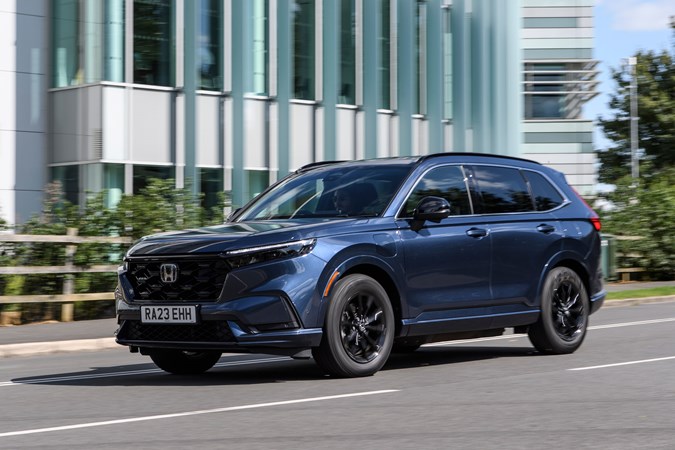
This doesn’t make it perfect, however. So let’s just take a quick check-in with a few reasons why you shouldn’t choose one of these.
So what are the negatives?
The first thing to consider is the price. At nearly £54,000 at current list prices, this is not a cheap family car by any measure, and you can find plenty of similarly sized SUVs for considerably less, many offering electrification of some form or another.
While nothing went wrong with it mechanically during its time with us, given the price, the quality of the paint is a little disappointing. To see the damage from the wiper arms at just over 10,000 miles is particularly upsetting; even if it must have been caused by human error (before it reached us, I hasten to add), that’s a fundamental design issue.
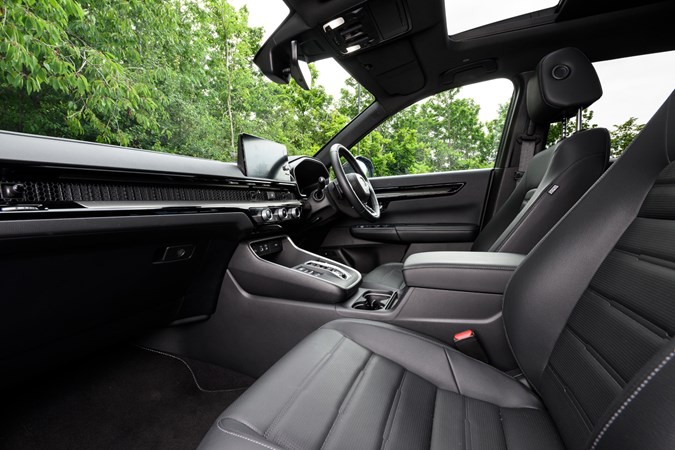
The inconsistent USB port connection was also very annoying. You can blame the cable, if you like, but the same wires worked fine in other cars over the same period, and the other CR-V I’ve tested recently (more on that in a moment) had exactly the same issue – which could be lessened by the inclusion of wireless Android Auto.
And finally, while generally more than acceptably practical, the lack of thought put into the user-friendliness of the boot is thrown into sharp relief by many rival brands. Something as simple as a means of propping-up the false floor while hunting for the charging cables would go a long way towards reducing the poor impression this makes in daily use.
With that small amount of complaint out of the way, let’s recap the good stuff a little more.
The good outweighs the bad by a huge margin
The top-spec CR-V is a smart-looking device, and it’s notable – especially compared with its replacement, which I’ll come to in a moment – that other road users seemed to take it reasonably seriously. Which is to say that I rarely struggled with people not observing good lane discipline during my commute. Something about the dark exterior trimmings and the slightly angry-looking cast of the daytime running lights, perhaps.
The efficiency, considering I wasn’t really running a plug-in hybrid in the most sensible way, was impressive for a petrol-powered SUV. Overall it achieved over 41mpg across 4,000 miles of very mixed driving. An important takeaway from this is just how much of an impact being able to regularly charge makes. A few journeys on EV power alone will see lifetime mpg rocket.
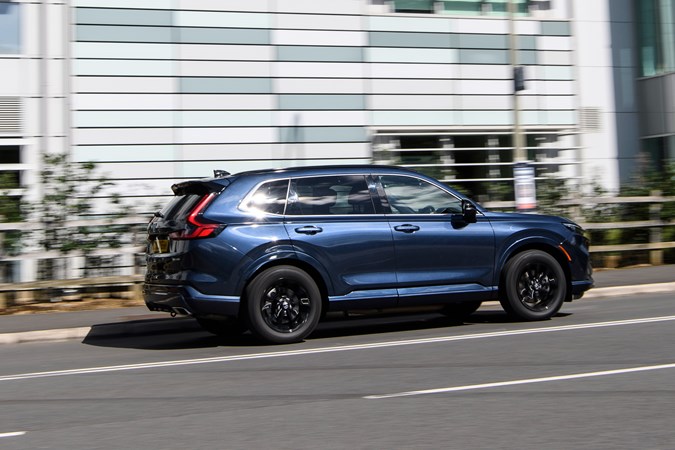
But even when I couldn’t charge it regularly, the CR-V does a great job of automatically marshalling its battery power, and the range-extender style integration of the petrol engine and the electric seems to work very effectively. I did miss not being able to charge the battery with the engine while doing longer journeys, but I’m not convinced that would actually have made it more efficient. (I just like having the option to roll around silently when I arrive at my destination.)
In terms of comfort, not only did the CR-V keep lengthy journeys relaxed, it also kept my kids from complaining they were feeling ill. It is not a sporty or particularly engaging car to drive – though certainly competent enough – but for a family wagon I’d take the Honda’s controlled comfort as a preference over too much firmness and fidgetiness, any day.
Add the sensible interior layout with its proper buttons, the roominess and the solid, rattle-free build quality, and the result is one comprehensively attractive vehicle for fuss-free family duties.
Is the plug-in hybrid worth the cost over the standard hybrid CR-V?
I didn’t get the chance to drive the e:HEV version of the CR-V before my e:PHEV returned to its maker. But I was able to borrow one shortly afterwards.
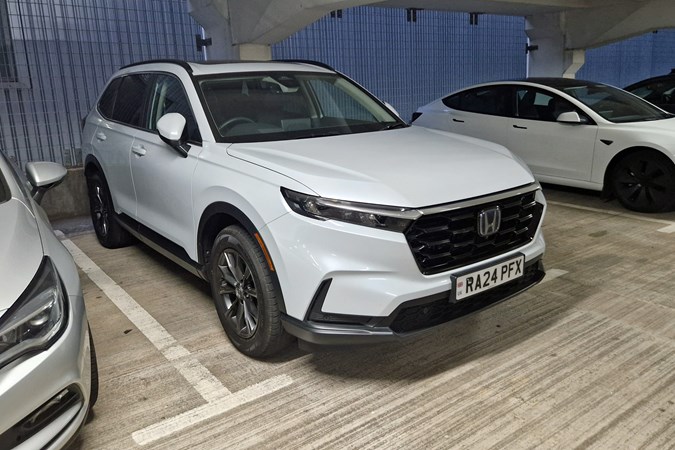
To recap the first report, there are some intriguing differences between the two variants that aren’t related to the size of the drive battery. All non-plug-in CR-Vs come with all-wheel drive as standard while missing out on even the option for adaptive damping. So I was intrigued to see if this pushed me into definitely preferring one or the other to drive.
The short answer is that it didn’t. The standard suspension is nicely judged, and very much in keeping with the character of the longer-term test car. I’d certainly not see this as a reason to upgrade to the e:PHEV.

On the other hand, I also didn’t get any particular feeling that the four-wheel drive system felt essential. I was trying it just as the year began to turn slippery, and yes, traction was great – and there’s a neat little display in the instrument cluster to reassure you that each of the wheels is really get struck into things – but at no point did I feel the plug-in would have been significantly disadvantaged. If anything, the regular hybrid’s steering felt a little heavier and the car a touch less wieldy, which I guess makes sense.
All told, while I’d probably opt for the longer electric range if money was no object, the difference in entry-level pricing is some £8,000. Which is not insignificant. So if you live in a region where all-wheel drive is likely to come in handy during the more inclement periods, dropping the plug is definitely worth considering.
What next for the family?
So having said a sad goodbye to the quietly confident Honda, I now find myself with the keys to another plug-in hybrid SUV – this time a seven-seater Volvo XC90 T8. Can this legend of the school run live up to its billing, or at over £84,000 (as tested), will it simply prove that less is sometimes more? I’ll link to the write-up of the new wheels as soon as it’s live.
| Honda CR-V e:PHEV Advance Tech | |
|---|---|
| Final mileage | 14,025 miles (~4,000 with us) |
| Real-world average fuel economy | 41.4mpg (lifetime) |
| Official combined fuel economy (WLTP) | 353mpg [sic – also, lol] |
| Parkers miles per pound calculation (mpp) | n/a |
| Car on Parkers fleet | June-September 2024 |
